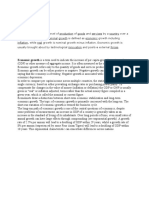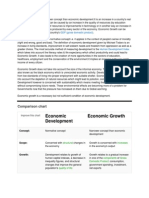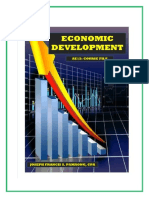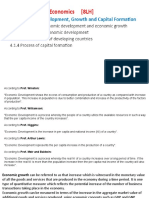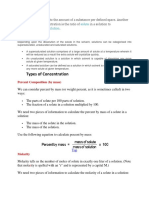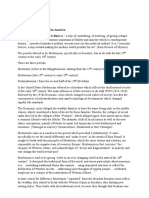0 ratings0% found this document useful (0 votes)
1 viewsCarribean Essay
Carribean Essay
Uploaded by
yacegeh627Copyright:
© All Rights Reserved
Available Formats
Download as DOCX, PDF, TXT or read online from Scribd
Carribean Essay
Carribean Essay
Uploaded by
yacegeh6270 ratings0% found this document useful (0 votes)
1 views2 pagesCopyright
© © All Rights Reserved
Available Formats
DOCX, PDF, TXT or read online from Scribd
Share this document
Did you find this document useful?
Is this content inappropriate?
Copyright:
© All Rights Reserved
Available Formats
Download as DOCX, PDF, TXT or read online from Scribd
Download as docx, pdf, or txt
0 ratings0% found this document useful (0 votes)
1 views2 pagesCarribean Essay
Carribean Essay
Uploaded by
yacegeh627Copyright:
© All Rights Reserved
Available Formats
Download as DOCX, PDF, TXT or read online from Scribd
Download as docx, pdf, or txt
You are on page 1of 2
Development is the process of improving the quality of life and well-being
of individuals in a society, which includes economic growth, social advancement,
and access to necessary services. It is quantified using a variety of indicators,
including the Gross Domestic Product (GDP), which indicates a country's
economic production, and the Human Development Index (HDI), which considers
life expectancy, education, and income levels. Additional indicators, such as
poverty rates and access to healthcare and education, provide a more detailed
picture of a country's overall development. Historically, industrialization and
economic expansion have driven development, with countries such as the United
States and Norway outperforming in both economic and social terms. Within this
perspective, both economic and sustainable development serve as important
indicators of a country's progress. Economic development evaluates rises in
national income, job creation, and overall economic output, whereas sustainable
development emphasizes long-term growth that balances economic, social, and
environmental variables. Both frameworks provide critical views to evaluate a
country's direction, with economic development emphasizing immediate
advantages and sustainable development emphasizing long-term, inclusive
growth. There are notable similarities and differences between sustainable
development and economic development that are crucial to understanding their
roles in shaping national progress.
Economic development refers to the sustained efforts aimed at improving
the standard of living and economic health of a country by increasing economic
activity. This process focuses on economic growth, as measured by key indicators
such as Gross Domestic Product (GDP), which represents the total monetary
value of all goods and services produced within a country over a specific period,
reflecting the overall economic performance. Another important measure is per
capita income, the average income earned per person in a given area, which
gauges the economic well-being of the population and assesses living standards.
Additionally, employment rates, indicating the percentage of the labor force that
is employed, provide insight into job availability and the overall health of the job
market. Healthy economic development is evident through consistent growth in
output and productivity, driven by capital investment, job creation, and
advancements in technology. These elements enhance production efficiency and
contribute to higher income levels and wealth accumulation among the
population. Ultimately, economic development aims to elevate living standards,
reduce poverty, and provide individuals and communities with access to
opportunities for prosperity.
Sustainable development is the planned and balanced use of a society's
resources to provide for itself without compromising future generations' ability to
satisfy their requirements. It emphasizes avoiding actions that will have a
negative impact on the future. This thorough strategy aims to strike a balance
between economic advancement, environmental protection, and social equality.
The Human Development Index (HDI) is a key measure of sustainable
development since it analyzes a country's average achievements in health,
education, and income, providing a broader view on well-being than just
economic performance. Another vital metric is carbon emissions, which evaluate
the environmental impact of economic activity and the success of policies aimed
at lowering greenhouse gasses. Furthermore, access to education and healthcare
are important indicators of social fairness and a population's quality of life.
Sustainable development prioritizes responsible resource management, social
inclusion, and long-term environmental health to ensure that economic growth
benefits both society and the world.
You might also like
- Heavy Metals Pollution of Soil Toxicity and Phytoremediation TechniquesDocument13 pagesHeavy Metals Pollution of Soil Toxicity and Phytoremediation TechniquesIJARP PublicationsNo ratings yet
- Creep Failure of HP Modified Reformer TubeDocument20 pagesCreep Failure of HP Modified Reformer Tubearaujo angel100% (1)
- Differences Between Economic Growth and Economic DevelopmentDocument7 pagesDifferences Between Economic Growth and Economic DevelopmentGizem ÖzçelikNo ratings yet
- Economic Growth and DevelopmentDocument27 pagesEconomic Growth and Developmentakshat100% (2)
- Economic DevelopmentDocument7 pagesEconomic Developmentmuhammad_ullah75% (4)
- The Global Case For Strategic Asset Allocation and An Examination of Home Bias - Thierry PollaDocument20 pagesThe Global Case For Strategic Asset Allocation and An Examination of Home Bias - Thierry PollaThierry PollaNo ratings yet
- Economic GrowthDocument5 pagesEconomic GrowthMay Fleur MayaoNo ratings yet
- Sociology of Development Notes EnglishDocument19 pagesSociology of Development Notes Englishvinnysaju123No ratings yet
- Urban PLanning NotesDocument22 pagesUrban PLanning NotesCarlo CapiliNo ratings yet
- Module 4-Economic DevelopmentDocument3 pagesModule 4-Economic Developmentjessafesalazar100% (1)
- Module 1 - Economic DevelopmentDocument3 pagesModule 1 - Economic DevelopmentjessafesalazarNo ratings yet
- ASSIGNMENTDocument10 pagesASSIGNMENTJOSHUA DEBORAH PEACENo ratings yet
- Differentiate B-WPS OfficeDocument2 pagesDifferentiate B-WPS Officelabejasanto0No ratings yet
- Lecturenote - 1532939641Ch1 Note DEDocument7 pagesLecturenote - 1532939641Ch1 Note DEtehreem nasirNo ratings yet
- L 4 ShortnotesDocument17 pagesL 4 Shortnotessauravgupta1311No ratings yet
- Economic Growth: Economic Growth Is A Term Used To Indicate The Increase of Per Capita Gross Domestic ProductDocument3 pagesEconomic Growth: Economic Growth Is A Term Used To Indicate The Increase of Per Capita Gross Domestic Productram1986_ramdasNo ratings yet
- Economic Policies of IndiaDocument35 pagesEconomic Policies of IndiaVishant BothraNo ratings yet
- Economic Development Economic Development Is The Development of Economic Wealth of CountriesDocument7 pagesEconomic Development Economic Development Is The Development of Economic Wealth of CountriesTamba KendemaNo ratings yet
- Economic DevelopmentDocument3 pagesEconomic DevelopmentHassan MurtazaNo ratings yet
- Development and GrowthDocument5 pagesDevelopment and GrowthRoshan BudhathokiNo ratings yet
- Question-1: Economic GrowthDocument18 pagesQuestion-1: Economic GrowthRachit SharmaNo ratings yet
- Quiz No. 1 (Final Term)Document5 pagesQuiz No. 1 (Final Term)Allen Kate MalazarteNo ratings yet
- Development Economic AssignmentsDocument4 pagesDevelopment Economic AssignmentsMunazzaNo ratings yet
- 100Document12 pages100tonnytube24No ratings yet
- Type and Indicators of DevelopmentDocument9 pagesType and Indicators of DevelopmentQuazi Moshrur-Ul-AlamNo ratings yet
- Book 5 Development EconomicsDocument83 pagesBook 5 Development EconomicsTaufeek IrawanNo ratings yet
- Human Development - A Robust Approach Towards Uganda Well BeingDocument21 pagesHuman Development - A Robust Approach Towards Uganda Well BeingdennisNo ratings yet
- 4TH Sem Indian Economy Lec 1Document7 pages4TH Sem Indian Economy Lec 1anilanitha974No ratings yet
- Ma Development Economics English Semester I MunotesDocument100 pagesMa Development Economics English Semester I MunotesBhushan ManjarekarNo ratings yet
- Human Development in IndiaDocument13 pagesHuman Development in IndiaMohit PaswanNo ratings yet
- Economic Growth Vs Economic DevelopmentDocument2 pagesEconomic Growth Vs Economic DevelopmentwittywhiteNo ratings yet
- Eco 316Document36 pagesEco 316Amarin MdNo ratings yet
- Development StudiesDocument43 pagesDevelopment StudiesmoviesandcartoontamilexplainchNo ratings yet
- Economic DevelopmentDocument19 pagesEconomic Developmentsdsdawood100% (1)
- New Microsoft Office Word DocumentDocument17 pagesNew Microsoft Office Word DocumentcarolsaviapetersNo ratings yet
- Main Sandra's Impact of Human Capital Development On Economic Growth in NigeriaDocument36 pagesMain Sandra's Impact of Human Capital Development On Economic Growth in NigeriaHaidee BellaNo ratings yet
- HDI of Jammu & Kashmir by Adnan NisarDocument11 pagesHDI of Jammu & Kashmir by Adnan NisarvoiddterminalNo ratings yet
- Growth and DevelopmentDocument86 pagesGrowth and Developmentricha ayengiaNo ratings yet
- Economic IndicatorsDocument9 pagesEconomic Indicatorsitantenna1No ratings yet
- Economic Problems Ch.1 2024Document6 pagesEconomic Problems Ch.1 2024Muhammad AbdelazizNo ratings yet
- International-Political-Economy Best VersionDocument5 pagesInternational-Political-Economy Best VersionRonson NgayawanNo ratings yet
- Economic Development & Economic GrowthDocument21 pagesEconomic Development & Economic GrowthRamsay GumilabNo ratings yet
- SustainabilityDocument13 pagesSustainabilityAnushkaNo ratings yet
- Economic Growth and Economic DevelopmentDocument2 pagesEconomic Growth and Economic DevelopmentmananmuhammadNo ratings yet
- Main ContentDocument26 pagesMain ContentjohnypegsusNo ratings yet
- Economic Growth and DevelopmentDocument1 pageEconomic Growth and Developmentjagdish002No ratings yet
- Group 1 Module 1 MidtermDocument6 pagesGroup 1 Module 1 MidtermGela ValesNo ratings yet
- Lec5-Health and DevelopmentDocument11 pagesLec5-Health and Developmentdouglaskiprono99No ratings yet
- Economic Development Vs Economic Growth - Difference and ComparisonDocument5 pagesEconomic Development Vs Economic Growth - Difference and ComparisonVarun ChaudharyNo ratings yet
- ECODEV 18 Assignment Nos. 4 Fundamentals Economic DevelopmentDocument4 pagesECODEV 18 Assignment Nos. 4 Fundamentals Economic DevelopmentCassie LyeNo ratings yet
- Block 1 MEC 008 Unit 1Document12 pagesBlock 1 MEC 008 Unit 1Adarsh Kumar GuptaNo ratings yet
- Development EconomicsDocument18 pagesDevelopment Economicssakibecon47No ratings yet
- Education Technology GDP (Gross Domestic Product) : Economic Growth Is A Narrower Concept Than EconomicDocument1 pageEducation Technology GDP (Gross Domestic Product) : Economic Growth Is A Narrower Concept Than EconomicIzhar Ali AbroNo ratings yet
- Human Development and HDIDocument8 pagesHuman Development and HDITushar PanchalNo ratings yet
- Ae12 Course File Econ DevDocument49 pagesAe12 Course File Econ DevEki OmallaoNo ratings yet
- New Devlopment EconomicsDocument39 pagesNew Devlopment EconomicsSom AcharyaNo ratings yet
- Economic Development Definition EssayDocument4 pagesEconomic Development Definition EssayDenitza TyufekchievaNo ratings yet
- Intro To Development EconomicsDocument24 pagesIntro To Development EconomicsUmair100% (1)
- (M2 - PPT) Principles and Concepts of Economic DevelopmentDocument26 pages(M2 - PPT) Principles and Concepts of Economic Developmentjohn carlos doringoNo ratings yet
- I There Must Be Good Policies: The Commission For Growth and Development Was Clear ThatDocument5 pagesI There Must Be Good Policies: The Commission For Growth and Development Was Clear ThatancasofiaNo ratings yet
- Chapter One-IntroductionDocument11 pagesChapter One-IntroductionkrizalidriotNo ratings yet
- NT20S Programmable Terminal: Operation ManualDocument308 pagesNT20S Programmable Terminal: Operation Manualelahmady.1409No ratings yet
- Sec2 Group1 Maru Batting CentreDocument9 pagesSec2 Group1 Maru Batting CentreAbsar HashmiNo ratings yet
- BYJUS Monthly Magazine June 2021Document157 pagesBYJUS Monthly Magazine June 2021GAGANA PNo ratings yet
- SWOT Analysis of The Different CompanyDocument19 pagesSWOT Analysis of The Different CompanycclaoNo ratings yet
- Conceptualizations of Development and Underdevelopment - The Works of Frank and Amin PDFDocument24 pagesConceptualizations of Development and Underdevelopment - The Works of Frank and Amin PDFAnushka AnandNo ratings yet
- Industrial RevolutionDocument24 pagesIndustrial RevolutionHafsah SiddiquaNo ratings yet
- Ewan Withers, Senior It Specialist Business Integration, Emea Websphere Lab ServicesDocument58 pagesEwan Withers, Senior It Specialist Business Integration, Emea Websphere Lab Servicesvenkateshit99No ratings yet
- Statistics IntroductionDocument3 pagesStatistics IntroductionNabanita DharNo ratings yet
- FASTADocument4 pagesFASTADhakshayani GNo ratings yet
- NSE Ikeja January 2017 News LetterDocument7 pagesNSE Ikeja January 2017 News LetterbbllngNo ratings yet
- Academic Calendar 2022 - 2023Document3 pagesAcademic Calendar 2022 - 2023Riginos PanteliNo ratings yet
- B.Pharmacy-4 Semester (New PCI Syllabus) : Drug Acting On Central Nervous SystemDocument4 pagesB.Pharmacy-4 Semester (New PCI Syllabus) : Drug Acting On Central Nervous SystemAli Veer Ali VeerNo ratings yet
- Bs DSIJ3517Document84 pagesBs DSIJ3517Ananya SaikiaNo ratings yet
- AXA PARENTERAL LIMITED - BrochureDocument6 pagesAXA PARENTERAL LIMITED - BrochureRajneesh VermaNo ratings yet
- Possible Exercise On Machine Element Two Flat BeltDocument4 pagesPossible Exercise On Machine Element Two Flat BeltAbebaw AyeleNo ratings yet
- Types of ConcentrationDocument2 pagesTypes of ConcentrationYana Allison GrandeNo ratings yet
- Dimensional FormulaDocument4 pagesDimensional FormulaSurajguptarocksNo ratings yet
- Logic Controller - Modicon M251 - TM251MESEDocument9 pagesLogic Controller - Modicon M251 - TM251MESEjuanbbvNo ratings yet
- Lectures of American LiteratureDocument9 pagesLectures of American Literaturemeriem18No ratings yet
- Cobb-Douglas Production Function For Measuring Efficiency in Indian Agriculture: A Region-Wise AnalysisDocument8 pagesCobb-Douglas Production Function For Measuring Efficiency in Indian Agriculture: A Region-Wise Analysispulkit sachdevaNo ratings yet
- Wolverine Reading OrderDocument2 pagesWolverine Reading OrderTomasHamNo ratings yet
- Angel Eyes How ToDocument2 pagesAngel Eyes How Toapi-3754618No ratings yet
- Lee Shemilt Progression Not CageDocument11 pagesLee Shemilt Progression Not CagegrazielaalvarezNo ratings yet
- Cfe Finals PrayerDocument2 pagesCfe Finals PrayerSatori SatoshiNo ratings yet
- 08.22.2023 - IntroductionDocument27 pages08.22.2023 - IntroductionArush SharmaNo ratings yet
- Publication 1 1129 24Document14 pagesPublication 1 1129 24Marwan FarhanNo ratings yet
- Abhijit Dhar - CV1Document2 pagesAbhijit Dhar - CV1Abhijit PhoenixNo ratings yet















